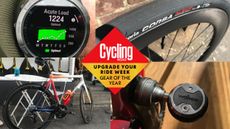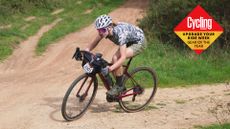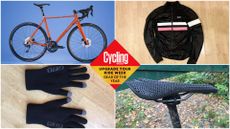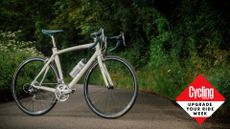Five simple upgrades to get the best out of your gravel bike
Here's how to to push your bike further – and go faster off-road
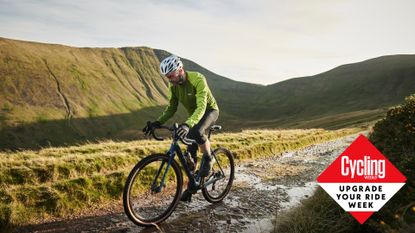

The latest race content, interviews, features, reviews and expert buying guides, direct to your inbox!
Thank you for signing up to The Pick. You will receive a verification email shortly.
There was a problem. Please refresh the page and try again.
Whether you’re a gravel devotee or recent convert, making a few sensible upgrades to your bike can greatly improve its performance, and with it the amount of fun you’ll have while riding it.
Now, unless you’re one of those very lucky people with thousands to spend on the verybest gravel bikes, you will – like the rest of us – be after the upgrades that will positively impact your riding without breaking the bank.
And although we did say ‘five upgrades’ in the title, it’s more five best upgrade areas – we’ve got lots more upgrade suggestions for you than just five! And some of them cost the same as a single Zwift payment – how’s that for value already?
Tyres (sealant and valves)

It’s hard to overstate the importance that tyres have on the overall ride quality of any bike, but perhaps even more so when it comes to riding off-road. Upgrading to a pair of thebest gravel bike tyreswill undoubtedly improve the performance and handling of your bike. But only if you carefully consider your needs.
Unlike the best road tyres, there’s more to take into account than just the rolling resistance, puncture resistance and weight.
‘Gravel’ can translate to a wide range of terrain and you’ll want a tread pattern to match. If you’re going to be primarily riding hard-pack gravel roads then you’ll probably be best to go with a semi-slick casing with shoulder knobs for better grip when cornering or a tyre that features an even covering of shallow and tightly spaced knobs that typically translates to predictable handling on mellow gravel.
However, if you’re regularly riding trails that are both loose and muddy then you’ll want to consider a more aggressive tread pattern. The height and spacing of the knobs should be taller and wider to provide the necessary traction in those more challenging conditions.

Then there’s the width. Depending on the roughness of the terrain (and the level of comfort you’re after), you might be best suited with anything from 35mm to 54mm – that’s 2.1 inches, and with the change in units indicating a switch into mountain bike territory. If you want to dig a bit deeper before you buy, we've an article dedicated tothe best size and tread pattern for your gravel bike.
When shopping for gravel tyres you’ll notice a range of price points. So what’s the difference between ‘entry level’ and something more expensive?
Like many bike components and accessories, a higher price tag usually makes for a lighter tyre made from more advanced compounds. This is particularly important if you ride where there are wet, slabby rocks, as it’s not the knobs that provide the grip there (there’s no way for them to dig in) but rather the compound of the rubber.
When it comes to punctures, though, the tyres are only one piece of the puzzle – the tubeless sealant you use also has a significant impact on whether they stay inflated. We’ve got a separate guide to thebest tubeless sealantshere – if you’re looking for an upgrade for yourfirst gravel bike, this is a great place to start.
The other piece of the tubeless puzzle is the valve. It’s an inexpensive upgrade that can make a sizable impact. Schwalbe does a great set with a chunky seal which actually lasts – unlike the thinner ones that can disintegrate after a hard season. Schwalbe’s also fits a 4mm allen key, which really helps when taking them in and out. Others designs are made to play nicely with tubeless inserts and have valve caps with valve core tightener, such asSTZY’s tubeless valves– very useful.
Handlebars (stem, saddle, bar tape)

It’s probably no surprise that your contact points significantly impact your comfort levels no matter your style of riding.
Whether your approach to gravel is about laid-back exploring, ultra distance epics or competitive racing, you’ll enjoy it more and perform better with a bike that fits you and your needs properly.
As we’re looking for affordable upgrades that offer the highest value, both your stem and your bar tape is a good place to start.
What’sbest for bar tapeis quite obvious – tackier and more cushioned options deliver better grip for more control, as well as greater comfort. Win win.
When it comes to stems it’s all about optimising your position. You’ll want to aim to strike a balance between not being too stretched out and also not too cramped. You can get models with different angles to help further adjust the height of your handlebars too.
If you’re new to gravel and coming from a road background, don’t assume that your preferred stem length on your road bike will translate. The geometry of your gravel bike will almost certainly differ as will the position you’re looking to attain.
You might also want to explore the option of a suspension stem. However, these don't come cheap so would only equate to good value if you're riding challenging terrain on a regular basis.
We’ve got other content on how to set up your bike, so it’s worth watching that first. But once you know what you're looking for, a stem that sorts your bike fit is one of the best cheap upgrades it’s possible to make.

A change in your handlebars can also pay dividends. There’s a huge range ofgravel barson offer, so as with the tyres you’ll want to take into consideration your riding requirements.
If you ride technical trails or want to expand your luggage carrying capabilities, then a wider bar can really help with both. It offers greater stability and control as well as more room up front for higher volume bar bag.
However, if speed is your primary concern, or your gravel routes take in a fair amount of tarmac too, then a narrower bar that allows for a more aerodynamic position could be a sound investment.
The other component of a gravel bar you’ll want to consider is flare. It tends to be personal, some find a more extreme flare comfortable on their wrists and appreciate the extra control when hunkered down in the drops. For others, aggressive flare is an ergonomic no-no. Coming back to aerodynamics, if you’re travelling long distances, you’ll be more comfortable and significantly faster on a set of tri bars or aero extensions.
If you’re planning on investing on a new set of gravel bars and are looking for the best value then alloy is likely to prevail over carbon. It’s usually far cheaper and the weight penalty is pretty insignificant.
Last but not least is the saddle. It is perhaps even harder to find thebest bike saddlefor you than it is to decide on a handlebar – but it’s definitely an important upgrade for your enjoyment on the bike.
Gravel-specific saddles tend to be shorter and wider than road saddles, but there’s no reason why you can’t use a road saddle for your gravel riding if it’s comfortable.
For more information onhow to find the right saddle for you, we’ve got a handy explainer just over here.
Brake cables and pads

This is more one for thebest budget gravel bikesthat use mechanical disc brakes rather than hydraulics.
Now, it’s true that hydraulic disc brakes do offer better modulation (control of the braking force) compared to mechanical disc brakes – they also make the braking action so much lighter (possible with a single finger).
但它也是事实,机械盘式制动器be unfairly maligned because, in being specced on cheaper models, other spec choices are made that hamper their performance. Essentially, mechanical disc brakes have the potential to be much better than the stock set up.
Most important is upgrading the outer cable housing. Cheaper housing compresses when you squeeze the brake lever, which leads to a spongy lever feel. More expensive housing gives a much more direct braking feel, which helps with modulation and also means much more of the power is being delivered to the brake, rather than wasted in the housing.
£40 / $50 might feel like a lot to spend on your brake cables, but considering what an effect it has, it’s one of the best cheap upgrades you can make.

Same goes for upgrading your brake pads. You don’t need to go for a ludicrously expensive model with cooling fins and all the rest – it’s the compound of the pad that’s most important and it doesn’t take too much to make a big step up from the budget pads that will likely have come stock in your calipers as the bike brand tries to save where it can - when looking for a replacement, check out our guide to thebest brake pads for gravel bikesfor our recommendations.
Multi-tool

While not an upgrade to your bike, carrying one of thebest multi-toolscan certainly enhance the quality of your ride. A mid-ride adjustment to your saddle height, a trail-side repair or puncture on the ride home can all be dealt with efficiently when you have the right tool.
As with many of the components we’ve already covered, there’s a plethora of cycling multi-tools on the market. Some appear to contain everything but the kitchen sink, while others are far more concise in their offering.
We’d suggest that both ends of the scale are best avoided. A multi-tool that packs in a whole raft of features often does so at the expense of being user friendly. The bits tend to be too small and difficult - and sometimes downright annoying - to use.
Equally a tool with too few features is likely to cause frustration. The last thing you want is to get caught short out on the trails, with repair or adjustment that you can’t fix.
The bits we look for are a complete set of allen keys from 2mm to 8mm, at least a T25 Torx head, a flat head and Philips head screwdriver, a chain tool, a valve core tool and a spoke tool.
In terms of other things we'd suggest bringing, a quick link for the chain and, if you’re running tubeless, a tubeless plug are musts. We’d also suggest tyre levers, a good old fashioned inner tube and a pump too - vital if you’re still using tubes but also a safety net for tubeless users too.
For longer bikepacking trips: spare brake pads, gear cable,puncture repair kit,CO2 inflators(useful for reseating a tyre) are the staples.
Cycling computer with mapping

Again this isn’t specifically an upgrade for your gravel bike but it’s one that can certainly help transform your riding.
If you’ve owned a gravel bike for some time there’s a good chance that you’ll have built up a pretty comprehensive mental map in your head of all your local trails. But if you’re new to getting off-road then investing in one of thebest cycling computersthat comes with mapping can help you explore further afield in the confidence that you’re not going to get lost.
Gravel’s popularity is in part due to its ability to get you off-the-beaten track, away from traffic and exploring new areas - and easy mapping really helps with this.
Of course, this doesn’t actually have to be done with bespoke cycling computer – there are plenty of mapping applications on your phone that will do an excellent job. Plus, depending on what you already own, the setup might not have to cost much at all.
The things you will need are your phone (of course), a robust mount (also consider your waterproofing requirements), a battery pack for charging your phone, and some form ofhandlebar bagto put your phone in.
Whichever way you go about riding with mapping, you’ll soon wonder how you got by without it before.

Thank you for reading 10 articles this month* Join now for unlimited access
Enjoy your first month for just £1 / $1 / €1
*Read 5 free articles per month without a subscription

Join now for unlimited access
Try first month for just£1 / $1 / €1
Get The Leadout Newsletter
The latest race content, interviews, features, reviews and expert buying guides, direct to your inbox!

After winning the 2019 National Single-Speed Cross-Country Mountain Biking Championships and claiming the plushie unicorn (true story), Stefan swapped the flat-bars for drop-bars and has never looked back.
Since then, he’searnt his 2ⁿᵈ cat racing licence in his first season racing as a third,completed the South Downs Double in under 20 hoursandEverested in under 12.
But his favourite rides are multiday bikepacking trips, with all the huge amount of cycling tech and long days spent exploring new roads and trails - as well as histories and cultures. Most recently, he’s spenttwo weeks riding from Budapest into the mountains of Slovakia.
Height: 177cm
Weight: 67–69kg
-
-
 Chloé Dygert bounces back to win first world title since horror crash
Chloé Dygert bounces back to win first world title since horror crash'The journey has been very tough,' says American in Glasgow
By Tom DavidsonPublished
-
 Will Tidball clinches 'dream' gold medal as GB claim first rainbow jerseys of World Championships
Will Tidball clinches 'dream' gold medal as GB claim first rainbow jerseys of World ChampionshipsGreat Britain took home two golds on the first day, when world records tumbled in the velodrome
By Tom DavidsonPublished
-
 Data-loving roadie selection: Simon Smythe's Gear of the Year 2022
Data-loving roadie selection: Simon Smythe's Gear of the Year 2022Forget about riding over small stones - cycling is really about producing big numbers, right? Here are 10 things that might help
By Simon SmythePublished
-
 Everything gravel - racing and riding: Anna Marie Abram's Gear of the Year 2022
Everything gravel - racing and riding: Anna Marie Abram's Gear of the Year 2022From the start line to bikepacking epics, these are my top kit picks for 2022
By Anna Marie HughesPublished
-
 North American Editor's picks: Anne-Marije Rook's Gear of the Year 2022
North American Editor's picks: Anne-Marije Rook's Gear of the Year 2022From an awesome Craiglist find, to ponchos, CBD, gravel tires and dog leashes, Rook's list is a smörgåsbord of cycling lifestyle items
By Anne-Marije RookPublished
-
 最好的自行车升级:和在哪里度过where to save
最好的自行车升级:和在哪里度过where to saveCycling can become an expensive hobby - the art to maximising your pennies is deciding where to spend them
By Michelle Arthurs-BrennanPublished
-
 Bikepacking adventure picks: Stefan Abram's Gear of the Year 2022
Bikepacking adventure picks: Stefan Abram's Gear of the Year 2022From the Garmin Edge 1040 Solar and its epic battery life to the perfectly-sized Therm-a-Rest Space Cowboy sleeping bag, these are my top kit picks for 2022
By Stefan AbramPublished
-
 Urban-utility-e-cargo-bike special: Hannah Bussey's Gear of the Year 2022
Urban-utility-e-cargo-bike special: Hannah Bussey's Gear of the Year 2022This year she's been hauling lifestyle changes and a whole lot of happiness in to a new rural life
By Hannah BusseyLast updated
-
 Winter warrior kit picks: Luke Friend's Gear of the Year 2022
Winter warrior kit picks: Luke Friend's Gear of the Year 2022A modern steel road bike, a 3D printed saddle, waterproof gloves and versatile insulated jacket
By Luke FriendPublished
-
 Five cost-effective upgrades to make a second-hand bike feel like new again
Five cost-effective upgrades to make a second-hand bike feel like new againWe run you through the most cost-effective ways to get a 'brand new' feeling from a second hand bike
By Stefan AbramPublished


